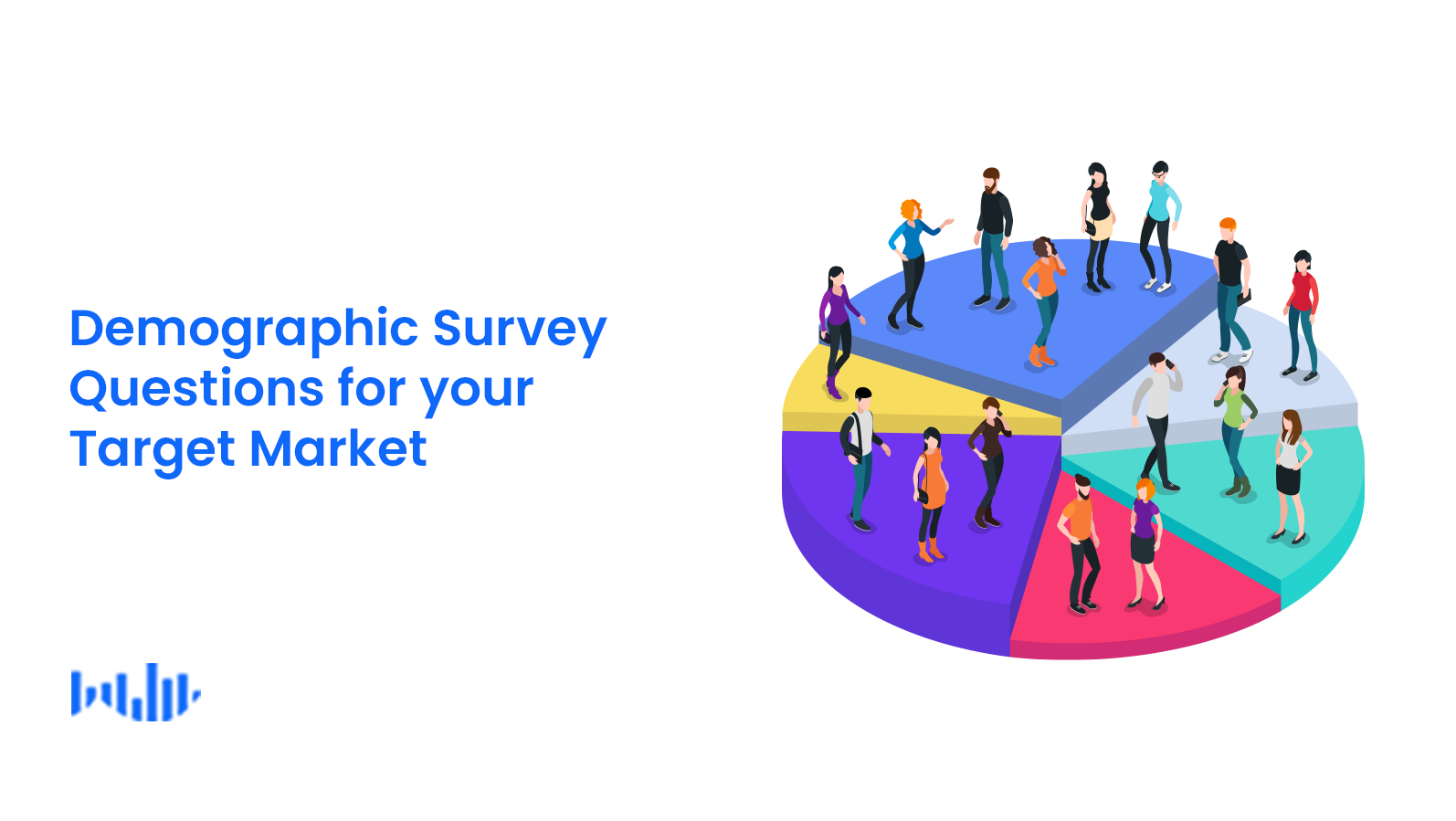Demographic Survey Questions to Reel in Your Target Market
 Demographic survey questions are the backbone of much of today’s survey research, as customer data has become increasingly important to businesses.
Demographic survey questions are the backbone of much of today’s survey research, as customer data has become increasingly important to businesses.
Although questions about age, marital status, education, or gender may seem simple on the surface, the data they provide is invaluable for segmenting your audience, targeting specific groups, and gaining profound survey insights.
But demographic survey questions are tricky; if you ask too many in your survey, you’ll annoy your participants. If you use a poor word choice, you risk making your audience suspicious or even offended.
In this article, we gathered the most common and useful demographic questions, examples of how you can use them in your surveys, and tips on making the most out of each.
Demographic Question #1: Age
How AGE information can be used:
- Create and polish generational-based personas. Age is often the defining factor in how people interact with your products, make decisions, or view things. No wonder there are so many age-based customer personas such as “40 y.o. office worker” or “17 y.o. college student.”
- Obtain age-unrelated insights. We often use age to segment different groups because we often perceive generations as different. But obtaining information about age also allows you to see when age doesn’t have any impact at all, making discoveries about how similar different age groups can think about the same things.
- Combine with other age-related available data. There’s a vast body of research online that focuses on behaviors and insights about different age groups. “Millennials more often…”, or “Generation X opposes…” You can combine this data with age-related insights from your surveys to obtain even more deep insights.
Tips on asking about the AGE:
- Use ranges. Age is sensitive information, so you’ll have a much higher response rate if you ask people to choose a range (e.g. 18-23) instead of providing a specific number.
- Use broad ranges or narrow ranges. If you survey the general audience, make sure you provide age ranges to cover all groups. (e.g. below 18, 18-23, 24-33, … above 65) If, however, you know that you’ll be surveying a group of young people and need more detailed age information, you can add more narrow ranges (17-18, 19-20, 21-23, other).
Example of AGE demographic question:
What is your age?
Below 18
18 – 24
25 – 34
35 – 44
45 – 54
Above 54
Demographic Question #2: Gender
How GENDER information can be used:
- Form gender-driven insights. Beware of jumping to conclusions when it comes to gender-specific insights. Often, survey data might surprise you.
- Expand to other audience groups. If you know that the target audience of your product is of a specific gender, you might target other gender groups to expand to other markets (e.g. popular men-driven gaming publication is looking for ways to expand its female audience)
Tips on asking about the GENDER:
- Don’t go all-in. Healthline currently lists 64 terms for gender identity, and if you ask participants to choose one out of 64, your survey will probably end sooner than you expect. List 5-6 most common options and cover the rest with “other.”
- Provide the way out. Gender is a sensitive topic, and some people might not want to share their details on it with you. Make sure to add the “Prefer not to answer” option to keep them in.
- Gender is not sex. Sex refers to biological distinction. Gender refers to the social or identity distinction. Don’t use “sex” and “gender” interchangeably in your questions.
Example of a GENDER demographic question:
What is your gender?
Male
Female
Trans-gender
Non-binary
Prefer not to answer
Other (please specify)
Demographic Question #3: Ethnicity
How Ethnicity information can be used:
- Diving into the cultural background of a specific group. Ethnicity may play a big role in people’s lives and affect their opinions by way of the traditions and customs they follow. As such, their views may occur through the lens of the culture that’s tied to their ethnicity.
- Enrich location-based surveys. There might be locations where a certain ethnic group holds the majority. Collecting information about ethnicity helps you discover hidden correlations or their absence by comparing survey data with data from larger audience samples.
- Target message to a specific ethnic group. If you have a business and want to join a message that resonates with certain ethnic groups, ethnic-driven surveys might be a great way to obtain actionable insights.
Tips on asking about the ETHNICITY:
- Make sure people can check off multiple answers. In the age of 23andme, more and more people consider themselves belonging to several ethnic groups, so provide your respondents with the ability to select several answers or you risk turning them away.
- Remember that ethnicity and race are different. Although closely connected, race and ethnicity are different. “Race” defines the largest categorization of people, while ethnicity is a subgroup, tied to a nationality. For example, “White” is a race, whereas “Irish” is an ethnic group falling under that race.
- Eliminate the words “ethnicity” and “race” if possible. Race and ethnicity are sensitive topics and often serve as a basis for discrimination. Try using the word “category” and let people choose the answer from groups as the following example shows.
Example of ETHNICITY demographic question:
What category describes you best?
White (e.g. Polish, German, English, Russian, etc.)
Hispanic Latino or Spanish origin (e.g. Mexican, Puerto Rican, Mexican American, Cuban, etc.)
Black or African American (e.g. African American, Haitian, Somalian, etc.)
Asian (e.g. Chinese, Japanese, Vietnamese)
American Indian (e.g. e.g Navajo, Mayan, Aztec, Nome Eskimo community, etc.)
Native Hawaiian or Other Pacific Islander
Middle Eastern or North African (e.g. Syrian, Egyptian, Lebanese, etc.)
Some other race, ethnicity, or origin
Demographic Question #4: Marital Status
How MARITAL STATUS information can be used:
More often than not, the information about marital status may not appear to be necessary, as other demographic questions will provide much clearer insight into your target audience’s choices and behaviors.
But there are cases where it can be an important differentiator, e.g. when you want to target very specific demographic groups, such as recently divorced people, etc.
Tips on asking about MARITAL STATUS:
- Beware of misinterpretations. It’s easy to jump to conclusions based on people’s marital status, especially with so many stereotypes and anecdotes floating around. In this case, it’s better to trust your data and numbers than the gut.
- Consider if you need this information. As with almost any demographic question, better ask yourself how you are going to use his data before adding the question.
- How to appeal to this demographic: To make the most use out of this demographic, consider the products, services and shopping behaviors of married respondents. These may be more willing to spend on vacations or activities designed for two.
Example of MARITAL STATUS question:
What is your marital status?
Single
Married or in a domestic partnership
Divorced
Widowed
Other
Demographic Question #5: Income or Employment
How Income or Employment information can be used:
- Obtain the economic profile of your audience. Income and employment are both strong differentiators for almost every survey as financials play a great role in how people choose what they buy and what they do.
- The differentiator in finance-specific surveys. If you are conducting a survey about finances, e.g. asking people about how they manage their personal spending habits, both income and employment will have a great impact on the results of your survey.
Tips on asking about EMPLOYMENT and INCOME:
- The money is in the follow-up. Research shows that if you ask participants to provide a specific income number with the “Don’t know” option, and then follow up with a question with income ranges (e.g. $10,000 – $20000), you’ll get more responses and than merely asking income range off the bat.
- Estimate based on other data. Not all people like to share their income details, but you might obtain income-related data indirectly. For example, if you already asked about respondents’ location and employment, you might check average salaries for that area and come up with an approximation.
Example of Employment survey question:
Full-time employment
Self-employed
Part-time employment
Underemployed (wage is below industry average)
Full time freelancing
Unemployed (looking for work)
Unemployed (not looking for work)
Student
Unable to work
Example of Income survey question:
How much total combined money did your household earn in 2020?
Less than $20,000
$21,000 – $30,000
$31,000 to $40,000
$41,000 to $50,000
$51,000 to $60,000
Above $60,000
Making The Most Out of Demographic Questions
Demographic questions help directly identify your target audience along with obtaining unique insights about a specific group of people.
Just make sure you only use those demographic questions that you really need for your research. For example, if you know that your audience is predominantly students, there’s rarely a need to ask for age, education, and type of employment.
With online survey platforms, demographic criteria can be specified before the survey starts.
If you want to take your surveys to the next step and collect even more actionable data, why not target groups that you want to survey from the very beginning?
With Pollfish you can target the right survey audience in 160 countries with over 20 various criteria such as age, gender, marital status, income, education, and even mobile device manufacturer.
Try Pollfish now and finally get advanced market insights that you can rely on.
Frequently asked questions
What is a demographic survey question?
Demographic survey questions are used to better understand the identities of the survey respondents. This information can be used to segment the survey audience in order to see how responses change based on demographic criteria.
What information is gathered through demographic survey questions?
Demographic survey questions are used to gather specific, objective information about the respondent, such as age, education, marital status, gender, household income, and employment status.
How can information about age be used when interpreting survey results?
Demographic information about survey respondents’ ages is used to create personas, understand how age impacts actions and beliefs, and identify factors that are universal amongst the respondents and not linked to age.
Why should researchers use ranges as a response to age questions?
Since some people are sensitive about age, respondents may feel more comfortable about selecting an age range rather than stating their exact age.
How many demographic questions should be included in a survey?
To ensure an optimal response rate, it is best to ask only the demographic questions you need to support your survey. When asked too many questions, respondents may get annoyed or bored and decide not to complete the survey.
Pollfish Marketing Team
Ready to Try Pollfish?
Create your survey with AI, target high-quality respondents starting at $0.95 per complete, and start getting results in just minutes in real-time. From running a simple product concept survey to managing a constant stream of trackers for dozens of clients in dozens of countries, we’ve got you.


